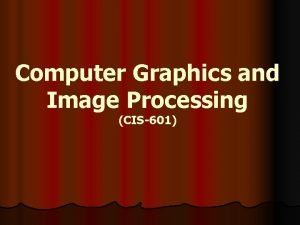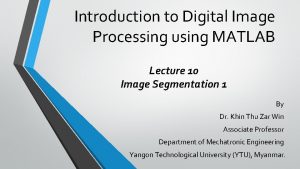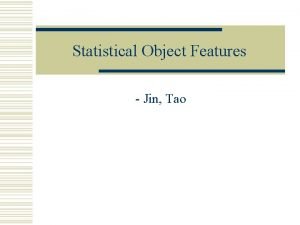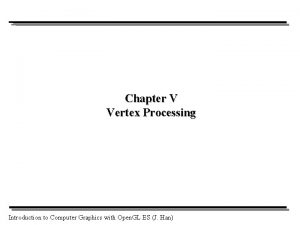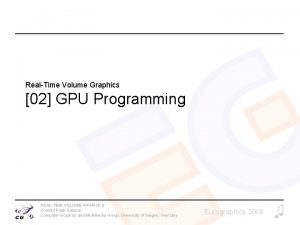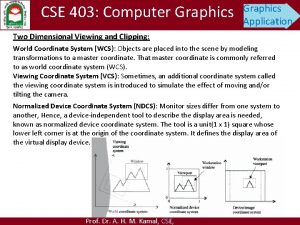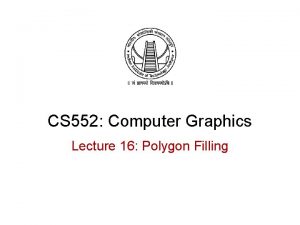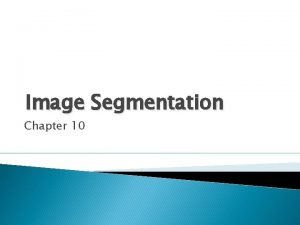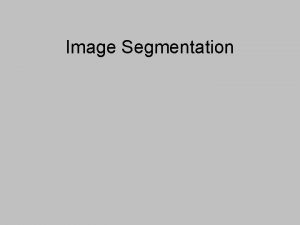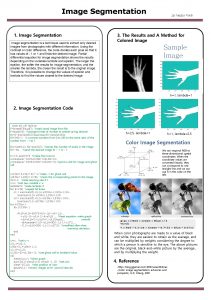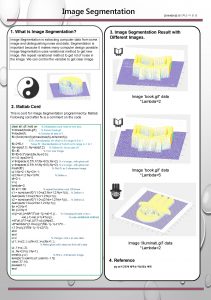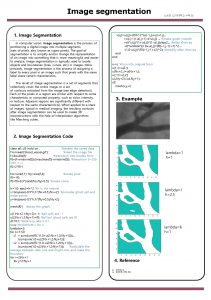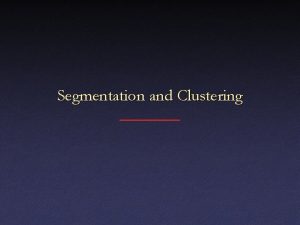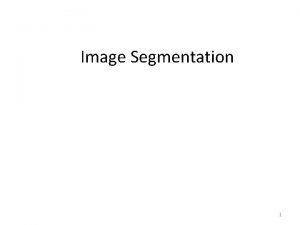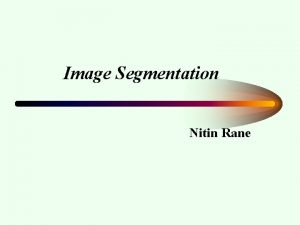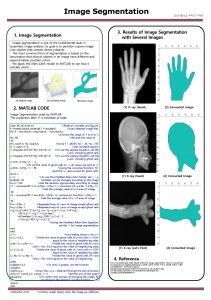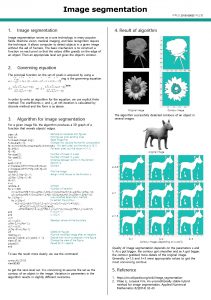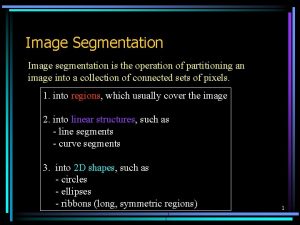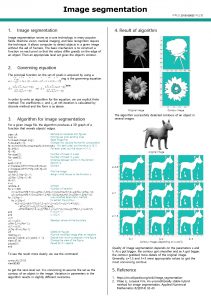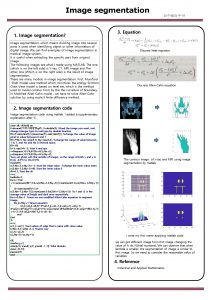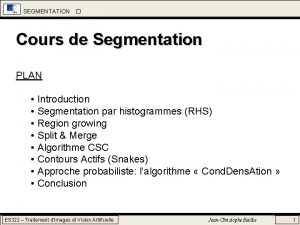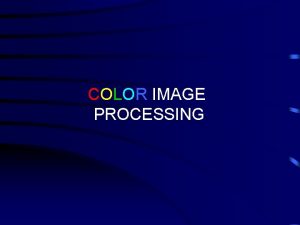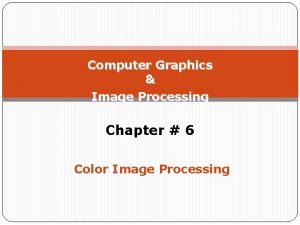Computer Graphics and Image Processing CIS601 Image Segmentation





































- Slides: 37

Computer Graphics and Image Processing (CIS-601)

Image Segmentation by Clustering (Using Mahalanobis Distance) - Manjit Chintapalli

What is Image Segmentation ? n To humans, an image is not just a random collection of pixels; it is a meaningful arrangement of regions and objects. n There also exits a variety of images: natural scenes, paintings, etc. Despite the large variations of these images, humans have no problem to interpret them.

Image Segmentation ? (Contd. . ) Image segmentation is the first step in image analysis and pattern recognition. n It is a critical and essential component of image analysis system, is one of the most difficult tasks in image processing, and determines the quality of the final result of analysis. n

The Process… n Image segmentation is the process of dividing an image into different regions such that each region is homogeneous.

Image Segmentation methods

Image segmentation methods can be categorized as follows (this is not an exhaustive list): Histogram thresholding n Edge-based approaches n Region-based approaches n Hybrid: consider both edges and regions. n

Continued… Segmentation of texture by PCA n Segmentation of texture with moments n

Color Image Segmentation n Image segmentation based on color n We use clustering to segment an image according to color features

Clustering ? n Clustering is a common step to get a segmentation n In the data space, clusters are regarded as regions of similar data points

Clustering…. Similar data points grouped together into clusters.

Clustering… Most popular clustering algorithms suffer from two major drawbacks n First, the number of clusters is predefined, which makes them inadequate for batch processing of huge image databases n Secondly, the clusters are represented by their centroid and built using an Euclidean distance therefore inducing generally an hyperspheric cluster shape, which makes them unable to capture the real structure of the data. n This is especially true in the case of color clustering where clusters are arbitrarily shaped

Clustering Algorithms K-means n K-medoids n Hierarchical Clustering n There are many other algorithms used for clustering. n

K-means Clustering Algorithm Step 1: Choose K cluster centers: c¹(1), c²(1), c³(1)…. . Step 2: At the kth iterative step distribute the samples among the K cluster domains, using the relation for all x in S(j), if |x – Cj (k)| < |x – Cj (k)| Step 3: Compute the new cluster centers

Algorithm continued … Step 4: If the algorithm has converged and the procedure is terminated. Otherwise go to Step 2 S(j): contains data points in RGB space x: is the data point in an iteration C(j): is the center of the cluster

How the problem was approached ? First the images are read from the directory. n Then each image is transformed into a 3 -D RGB space. n K-means clustering using Mahanalobis distance and Euclidean distance was applied. n

Continued…. . Next, the mean color of each cluster is calculated. n Then it is transformed back from 3 -D space. n Result : Segmented image n

Mahalanobis Distance n n n M. D. is a very useful way of determining the ”similarity” of a set of values from an ”unknown”: sample to a set of values measured from a collection of ”known” samples Superior to Euclidean distance because it takes distribution of the points (correlations) into account Traditionally to classify observations into different groups

Mahalanobis vs. other classical statistical approaches It takes into account not only the average value but also its variance and the covariance of the variables measured n It compensates for interactions (covariance) between variables n It is dimensionless n

Mahalanobis Distance n Dt(x) = (x – mt) S-1 t (x – mt)` Mahalanobis Distance

Euclidean Distance n The Euclidean distance is the straightline distance between two pixels n Euc dist = √((x 1 - x 2)² + (y 1 - y 2)²) , where (x 1, y 1) & (x 2, y 2) are two pixel points or two data points

After executing the program… Original Images

More images…

During execution… n n The images are transformed into 3 -D RGB space K-means clustering is applied which groups data points with similar color into clusters Example:

Continued… n The data points with minimum mahalanobis distance are grouped together into clusters. n After grouping into clusters, the mean color of the cluster is taken and mapped back into the image

Continued… n The program was executed with different number of clusters n The same program was run with Euclidean distance for distance between data points

Segmented Images

Original Image Segmented with 4 clusters Segmented with 6 clusters

Original Image 4 Clusters 2 clusters 6 Clusters

Original Image 4 Clusters 2 Clusters 6 Clusters

Mahalanobis vs. Euclidean

Original Image 4 clusters Mahalanobis 4 clusters Euclidean

Original Image 6 Clusters Mahalanobis 6 Clusters Euclidean

Original Image 6 Clusters Mahalanobis 6 Clusters Euclidean

Mahalanobis vs. Euclidean Result : Using Euclidean distance in the k-means clustering proved to be better than Mahalanobis distance.

Conclusion n The program runs with all jpeg images and takes a lot of time to run for larger images This is due to the calculation of the inverse of the covariance matrix for the mahalanobis distance The results show that Image segmentation using Mahalanobis distance works but, not better than Euclidean distance

The End
 Image segmentation in digital image processing
Image segmentation in digital image processing Graphic monitor and workstation in computer graphics
Graphic monitor and workstation in computer graphics Segmentation in computer graphics
Segmentation in computer graphics Introduction to computer graphics ppt
Introduction to computer graphics ppt Double thresholding in image processing
Double thresholding in image processing Introduction to digital image processing
Introduction to digital image processing Filteration
Filteration Amplitude
Amplitude Vertex processing in computer graphics
Vertex processing in computer graphics Neighborhood processing
Neighborhood processing Point processing in image processing
Point processing in image processing Histogram processing in digital image processing
Histogram processing in digital image processing Nonlinear image processing
Nonlinear image processing Point processing in image processing
Point processing in image processing Morphological dilation
Morphological dilation Computer vision vs image processing
Computer vision vs image processing Image transform in digital image processing
Image transform in digital image processing Optimum notch filter in digital image processing
Optimum notch filter in digital image processing Compression in digital image processing
Compression in digital image processing Fidelity criteria in image compression
Fidelity criteria in image compression Image sharpening and restoration
Image sharpening and restoration Image geometry in digital image processing
Image geometry in digital image processing Zooming and shrinking of digital images
Zooming and shrinking of digital images Image transform in digital image processing
Image transform in digital image processing Imtransform matlab
Imtransform matlab Image restoration in digital image processing
Image restoration in digital image processing Primary processing of wheat
Primary processing of wheat Batch processing vs interactive processing
Batch processing vs interactive processing Graphics processing unit
Graphics processing unit Gpu perfstudio
Gpu perfstudio Interior and exterior clipping in computer graphics
Interior and exterior clipping in computer graphics What is line drawing algorithm in computer graphics
What is line drawing algorithm in computer graphics Computer graphics ppt
Computer graphics ppt In two dimensional viewing system have
In two dimensional viewing system have Reflection and shearing in computer graphics
Reflection and shearing in computer graphics Mathematical foundations of computer graphics and vision
Mathematical foundations of computer graphics and vision Polygon clipping in computer graphics ppt
Polygon clipping in computer graphics ppt Region filling and clipping in computer graphics
Region filling and clipping in computer graphics


